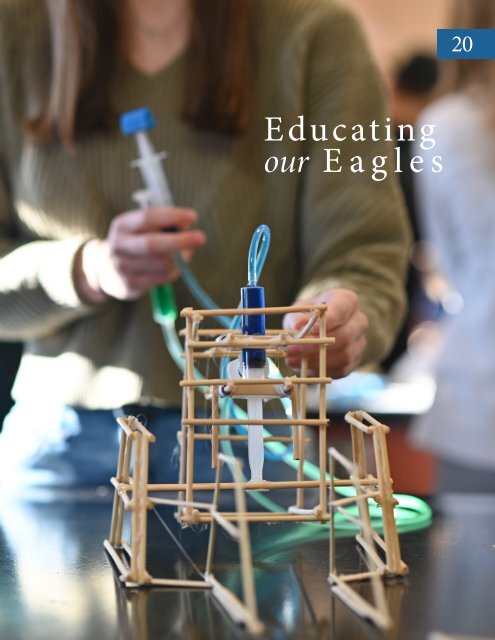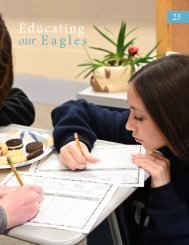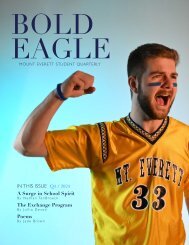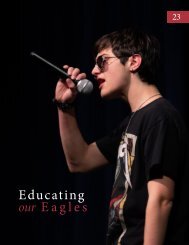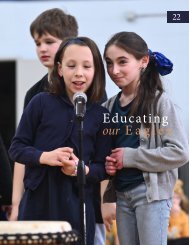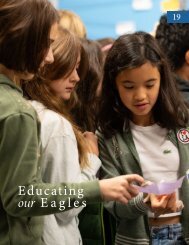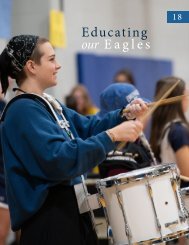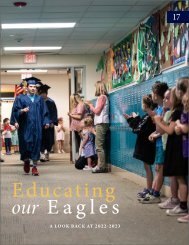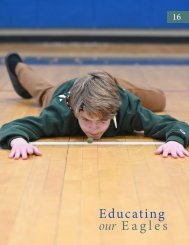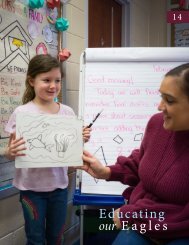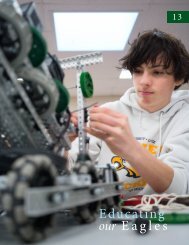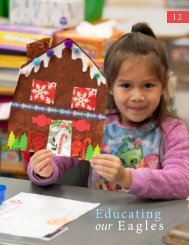Educating Our Eagles - Issue 20
Create successful ePaper yourself
Turn your PDF publications into a flip-book with our unique Google optimized e-Paper software.
<strong>Educating</strong><br />
our <strong>Eagles</strong><br />
<strong>20</strong>
CONTENTS<br />
4<br />
Introduction - Curriculum Director, Julie Dolan<br />
6<br />
High School - Train to Hadestown – Kevin Wolgemuth<br />
8<br />
High School - Cultural Awareness – Tara Johnston<br />
10<br />
Elementary School - Morning Centers – Carrere Tirrell<br />
12<br />
Elementary School - City/Village Collage – Sarah Cooke<br />
14<br />
High School - Portfolio Development – Stephanie Graham<br />
EDUCATING OUR EAGLES<br />
2
EDUCATING OUR EAGLES<br />
3
INTRODUCTION<br />
From SBRSD’s Director of Curriculum<br />
and Instruction, Julie Dolan<br />
Thankful for our School Community<br />
I am thankful for the opportunity to share a window into our classrooms<br />
each month, for all the work that Ms. Giordano does to make this beautiful<br />
publication come to life, and of course to all the faculty and staff for taking the<br />
time to showcase an educational experience they created for their students.<br />
A District goal this year is to deeply listen and incorporate the voice of<br />
our school community into our Strategy for Continuous Improvement. In<br />
particular, we are focused on elevating student voice. We strive to provide<br />
space for students to share the things they enjoy about their experience<br />
in school, as well as to impart their ideas and hopes for how we can work<br />
together to create positive impacts on improving school practices. It has<br />
been a pleasure to hear the students’ perspectives and to see them light<br />
up and engage in out-of-the-box thinking about ways to innovate and<br />
reimagine school.<br />
I want to convey my deep gratitude to all who are a part of making SBRSD<br />
such an amazing place to teach, learn, and work. The District is a school<br />
family with many gifts and talents which are shared each day with one<br />
another and our students. We are grateful for our SBRSD School Community<br />
who are willing to give selflessly of their time to make profound, positive, and<br />
lasting differences in the lives of students, and help guide them to learn, grow<br />
and find success on whichever path their future holds for them.<br />
Of course, we are thankful for our amazing, talented, creative, curious, and<br />
resilient students. They bring us joy, and sometimes they challenge us, they<br />
make us think, and they always make us want to be better.<br />
Happy Reading! We love sharing all the great things happening each day with<br />
all of you!<br />
All My Best,<br />
Julie Dolan<br />
Right: Mount Everett Principal, Jesse Carpenter reads to<br />
the Pre-K Integrated class.<br />
EDUCATING OUR EAGLES<br />
4
5
HIGH SCHOOL:<br />
Taking the Train to Hadestown<br />
Writing in the Humanities focuses on connecting literature with art and music,<br />
and classical tales with modern realities. To explore so many intersections,<br />
twenty-one Mount Everett seniors and three instructors visited New York<br />
City this November to take in a live performance on Broadway.<br />
Before the trip, students read the Greek myths of two couples, Hades and Persephone,<br />
and Orpheus and Eurydice. After examining symphonies and paintings created in<br />
response to the tales, students listened to music from Anais Mitchell's Tony Awardwinning<br />
musical, Hadestown. Conversations touched on enduring questions about<br />
youth and aging, identity, love, courage, politics and economics.<br />
The trip began with a train ride into Grand Central Station, continued with a walking<br />
tour of Times Square and Broadway before a lunch at Hard Rock Cafe, and culminated<br />
in a matinee at the historic Walter Kerr Theatre.<br />
As a result of instruction, students will be able to:<br />
• connect classical themes with modern issues, finding how old tales relate to their<br />
lives; identify patterns across visual, physical and textual media; and argue the<br />
relevance of live dramatic performances.<br />
Observations:<br />
Most remarkable was watching students experience live theater for the first time, hearing<br />
them chatter excitedly on the train ride home, and listening to their responses the next<br />
day. Some students cried at the performance. Others looked ready to leap over the<br />
balcony railing when the set opened up to re-create the hell of Hades. Many were at a<br />
loss for words to describe how vastly their in-person experience differed from reading or<br />
watching a film. For many students, this first trip to New York City expanded their world<br />
understanding. For many more students, this first trip to Broadway introduced them to a<br />
means of expression that they hadn't known.<br />
Since then, I've heard “the non-drama kids” singing show tunes, been asked by juniors if<br />
we'll do it next year, and had several participants say that they didn't like musicals before<br />
the show and now can't stop listening to the same tracks because they want to relive the<br />
experience. After the first run of a new activity or text, I often ask my students, “Should<br />
we use this again next year?” This time, I wasn't able to ask: students were telling me<br />
about when they will go back.<br />
MA Standards:<br />
English Frameworks (<strong>20</strong>17): Reading Literature 2, 3, 5, 6, and special emphasis on<br />
7 and 9, “Integration of Knowledge and Ideas”; Writing 3, 7 and 8; Speaking and<br />
Listening 2 and 3.<br />
EDUCATING OUR EAGLES<br />
6
EDUCATING OUR EAGLES<br />
7
HIGH SCHOOL:<br />
Cultural Awareness: Difficult Jobs<br />
Students in Spanish IV recently learned about the working conditions in some of the most<br />
difficult jobs around the world, and the story of the trapped Chilean Miners from <strong>20</strong>10.<br />
The class studied migrant workers and discussed how working as a team, and having<br />
strong leaders, helps people overcome the most difficult obstacles.<br />
As a result of instruction students will be able to:<br />
• Compare and contrast jobs and working conditions in Mexico, Chile, and the United<br />
States.<br />
• use team-building and leadership skills to solve problems.<br />
• learn the importance of work equality and regulations to protect workers rights.<br />
Observations:<br />
Students learned the importance of family, strong leadership, and working as a team. Students<br />
became aware of civil rights and working conditions in the 1940’s and 1950’s for migrant workers<br />
in the United States. Students learned of workers rights in Chile and the mining industry.<br />
MA Standards:<br />
Interpersonal Communication<br />
Interpretive Communication<br />
Social Justice<br />
Cultural comparisons<br />
EDUCATING OUR EAGLES<br />
8
Miner Claudio Yanez applauds as he is carried away on a stretcher after being rescued from the collapsed San Jose mine<br />
where he had been trapped with 32 other miners for over two months in <strong>20</strong>10 near Copiapo, Chile.<br />
Hugo Infante/AP<br />
https://www.npr.org/<strong>20</strong>14/10/29/359839104/the-incredible-story-of-chilean-miners-rescued-from-the-deep-down-dark<br />
EDUCATING OUR EAGLES<br />
9
ELEMENTARY SCHOOL:<br />
Morning Centers<br />
S<br />
tudents choose from a variety of morning activities that are linked to MA standards introduced<br />
in PreK and/or the Boston Public Schools Department of Early Childhood Focus on Pre-K<br />
curriculum.<br />
Because PreK at SBRSD is multi age (3, 4 and even 5 yrs old) and some students will be in<br />
the PreK for 2 years, the objectives vary based on age/development.<br />
Some the objectives were:<br />
• copy a pattern either depicted or molded for them<br />
• extend a pattern already started for them<br />
• created a pattern of their own<br />
Observations:<br />
Using colored chain links, some students were able to copy a given or drawn pattern. Others were<br />
able to extend a pattern by building on what had already been started. And some students were<br />
even created their own pattern using the colored links.<br />
MA Standards:<br />
Look for and describe patterns and relationships (PreK-LS1-2<br />
PreK-LS1-3,)<br />
EDUCATING OUR EAGLES<br />
10
EDUCATING OUR EAGLES<br />
11
ELEMENTARY SCHOOL:<br />
City/Village Collages<br />
The South Egremont School is thinking about what makes a city, or in our neighborhood, a<br />
village, work. Children are reading books about urban neighborhoods and thinking about all the<br />
interconnecting jobs that help a community to function. The books we are reading are helping<br />
children notice the details of the world around them—features like farms, fields, houses, mailboxes,<br />
traffic lights, garbage collection, important village buildings— and the people who do jobs that make<br />
our town work. This week we looked closely at illustrations of towns and cities in our books created with<br />
collage and learned about some amazing collage artists like Roamer Bearden, Ekua Holmes and Mark<br />
Bradford. Children began working on their own collaged cityscapes. They tore, cut, arranged, organized<br />
and adhered interesting shapes and textures to create amazing cities and neighborhoods at night.<br />
As a result of instruction, students will be able to:<br />
• demonstrate initiative, self -direction, and independence.<br />
• create representations of experiences or stories and explain them to others.<br />
• with guidance and support, use a combination of drawing, building with blocks or other materials, or<br />
dictating to construct maps and other representations of familiar places.<br />
Observations:<br />
Ms. Didi and I noticed how incredibly focused and engaged the entire class was as they "shopped" for<br />
materials, tried things out and built multi-layered images of homes and neighborhoods where many people<br />
lived. It was interesting to hear ideas and stories shared as they worked - about restaurants, traffic lights,<br />
playgrounds, schools and post offices!<br />
"We can put some stars in later, because this is the city at night!" "I'm going to make a person walking." "Mine<br />
has a horse because a horse can pull a carriage there."<br />
MA Standards:<br />
APL1., APL4., SL.PK.5 , PK.T2.3<br />
EDUCATING OUR EAGLES<br />
12
EDUCATING OUR EAGLES<br />
13
HIGH SCHOOL:<br />
Portfolio Development<br />
Advanced level art students in Portfolio class work with a variety of media and techniques in their artwork.<br />
They spend the semester contributing to a body of work that exemplifies both breadth and depth. In the first<br />
quarter, they are given assignments that challenge them in a certain medium. They go through an artistic thinking<br />
process of exploration, practice, and concept development before completing their compositions. Students will<br />
hone in on a passion or idea in a sustained investigation in the second quarter. They document their work and<br />
create a website to house and share their portfolio, which in the end, is comprised of about 15 pieces of their best<br />
work from the past two years.<br />
As a result of instruction, students will be able to:<br />
• use the artistic thinking process to problem solve, build technical skills, and develop ideas.<br />
• create a body of work that shows artistic growth, the communication of ideas, risk-taking, and personal voice.<br />
• document and share a collection of artwork, including an artist statement.<br />
Observations:<br />
Depending on their personal goals – whether it be applying to an art program or a creative field, building<br />
skills, etc., students are typically at varying stages of artistic development and practice. The class works well<br />
because each assignment allows them either work with new materials or take their previous experience to a new<br />
level. They are measured by their growth, effort, and knowledge and application of the elements and principles<br />
of art in the communication of ideas. Sometimes colleges have specific criteria to include in their portfolios, or<br />
students may have a particular artistic career path in mind. The class allows them to focus on their needs as they<br />
prepare for their future.<br />
MA Standards:<br />
Generate original ideas that integrate aesthetic principles with individual personal style while pushing the<br />
boundaries of style, genre, medium, and connections (A.V.Cr.01).<br />
Document personal strategies used regularly to organize artistic ideas (A.V.Cr. 02)<br />
Select, analyze, and interpret artistic work for presentation. Organize and plan an art exhibition that explores a<br />
personally meaningful theme, idea, or concept. ((A.V.P.06)<br />
EDUCATING OUR EAGLES<br />
14
EDUCATING OUR EAGLES<br />
15
HIGH SCHOOL:<br />
Portfolio Development (continued)<br />
Evelyn Vollmer, grade 11<br />
EDUCATING OUR EAGLES<br />
16
Ivy Ben Webster David, grade 12<br />
Shira Sawyer, grade 12<br />
EDUCATING OUR EAGLES<br />
17
EDUCATING OUR EAGLES<br />
18


